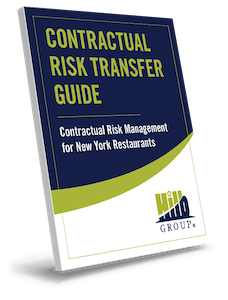
As a hospitality business owner, you know that renovating your space is a great way to keep the atmosphere updated and inviting for current and potential customers, which helps grow your business. It also allows you to make structural upgrades needed for safety and efficiency purposes.
However, there are many unknown challenges and risks prompted by the New York Labor Law that can impact both your restaurant, bar, or other hospitality business renovation and operation. It’s essential to understand the potential pitfalls to protect you and your business.
Below, I discuss renovation exposures and provide solutions, including a sample document with insurance requirements, indemnification, and hold harmless provisions you must consider when working with contractors and vendors.
Hospitality business renovation risks
New York Labor Law 200/240/241 holds property owners and contractors strictly liable for “gravity related” injuries that happen on the jobsite, which can be serious and even fatal. These injuries can be caused by falling from any height, including a ladder, or slipping, but could also be a result of a falling objects that could cause a struck-by injury.
The New York state Labor Laws applies to nearly every activity involving construction and repair on your premises, and there is virtually no defense from a lawsuit even if the worker’s negligence contributed to or caused the incident. Many hospitality business owners are not aware of the exposure presented by the New York Labor Law 200/240/241 and this can result in insufficient insurance coverage, unnecessary financial responsibility, and significant costs.
You could be financially responsible for:
- Injuries to individuals and the employees of general contractors and subcontractors that you or another contractor hired
- Injured workers or other injured third parties even if you didn’t supervise or control the job site, supply materials, select equipment or choose the employees doing the work
- Injuries to contractors hired by a tenant without the property owner’s knowledge
Here are some examples of lawsuits involving the New York Labor Law 200/240/241 that could happen to your business:
- $5,524,716 verdict – A worker fell 20 feet through an open section of railing while working at a renovation site. He landed in the building’s sub-basement and suffered injuries to his ankles, heels and back.
- $7,000,000 settlement – A construction worker fell 25 feet off a partially constructed stairway and injured his ankle, back, neck, ribs, and wrist, and claimed the unprotected stairway and lack of safety devices allowed fall.
How to mitigate your New York Labor Law liability
The most effective way to avoid the risks of a hospitality business renovation is to mitigate the potential liability posed by the New York Labor Laws. There are two primary ways to accomplish this:
Contractual risk transfer
Contractual risk transfer refers to the use of written contractual agreements, which include hold harmless and indemnification clauses, waivers of subrogation, insurance procurement clauses as well as payment and performance surety bonds to transfer liability to the general contractor.
Proper review of insurance policies and endorsements
In addition, the contract should require that all general contractors and subcontractors that do any work for your business maintain sufficient insurance policies with minimum limits of liability that satisfy the following requirements:
- The contractor’s General Liability policy should not include an Action Over or New York Labor Law exclusion (i.e., There shall be no “Injury to Subcontractor Employee” (or its equivalent) exclusion);
- Third party vendors should provide you with their complete insurance policies and their respective schedules of forms and endorsements;
- The following should be included in the DESCRIPTION OF OPERATIONS section of their Certificate of Insurance: “There are no third party-over action exclusions or similar endorsements or limitations as part of the General Liability policy evidenced on this Certificate;” and
- A signed letter from the general contractor’s insurance company or advisor should include the statement in the point directly above.
Have all contracts you plan to enter into, from your rental lease to any and all subcontractor agreements and vendor contracts, reviewed and approved by legal counsel before you sign and agree to the terms.
Proper review of your business insurance policies and endorsements is also recommended during renovation to make sure you have adequate coverage. Policies that should be reviewed include, but are not limited to:
- General Liability
- Auto Liability
- Workers’ Compensation and Employers’ Liability
- Pollution Liability
- Umbrella Liability (or Excess Liability)
- All other insurance coverages required by law
If you are considering a renovation for your restaurant or hospitality business, implementing contractual risk transfer, and regularly reviewing your business insurance policies, as well as those of your general contractors and subcontractors, should become a standard part of your business operations to mitigate risk from the New York Labor Law 200/240/241.
As a bonus, download our Contractual Risk Transfer guide below, which provides sample language for insurance requirements, as well as indemnification and hold harmless provisions, that you can reference when working with your trusted legal counsel and insurance advisor.
Should you have any questions about this topic or need insurance coverage, contact me at nowens@hilbgroup.com.
Download Our Guide

